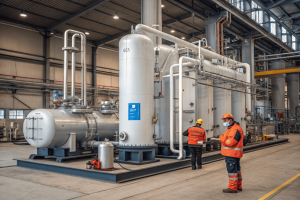How does CO₂ Enhanced Oil Recovery (EOR) provide a potential revenue stream for CCS projects?
•
What are the capital expenditure (CAPEX) and operating expenditure (OPEX) concerns for new CO2 capture facilities?
Your project budget is tight. CAPEX is a huge hurdle, and hidden OPEX can sink your project. You need to control costs from day one to ensure long-term viability.
The biggest CAPEX concern is the high upfront cost of the capture plant and compression equipment. For OPEX, the main worry is the ongoing "energy penalty"—the cost of steam and electricity—plus solvent makeup and maintenance. These factors dominate the project's financial model.

I've sat in countless project meetings where the numbers on the spreadsheet make or break the entire venture. It's not just about the engineering; it's about making the project pay for itself. The costs are real, but so are the opportunities. Some projects can turn captured CO₂ from a liability into an asset. Let's explore how that works and what factors influence the financial picture.
How does CO₂ Enhanced Oil Recovery (EOR) provide a potential revenue stream for CCS projects?
You've captured the CO₂, but now you have to pay for storage. This cost offers no return. Enhanced Oil Recovery (EOR) offers a way to turn this expense into revenue.
In EOR, CO₂ is injected into aging oil reservoirs. It acts like a solvent, making the trapped oil less viscous and easier to extract. Oil companies will pay for this CO₂, creating a valuable revenue stream that helps offset the high cost of capture.
")
For decades, the oil and gas industry has been using CO₂ to get more out of their wells. This creates a ready-made market for captured carbon. Instead of just being a cost center for disposal, the CO₂ becomes a commodity that can be sold. We engineer our capture systems to produce CO₂ that meets the specific pressure and purity requirements for EOR applications. For a project to be viable, the capture facility usually needs to be located relatively close to an oil field to avoid massive pipeline transportation costs.
The EOR Business Model
This method provides a unique dual benefit. It generates revenue from oil production while also permanently storing the CO₂ underground in the same geological formation. However, the financial viability is often tied to the price of oil. When oil prices are high, the demand for CO₂ for EOR is strong. This link to a volatile commodity is a risk that every EOR-based project must carefully manage in its financial planning.
| Storage Method | Primary Goal | Financial Model | Key Dependency |
|---|---|---|---|
| Saline Aquifer | Permanent CO₂ storage | Cost Center (Disposal) | Carbon tax/credits |
| Enhanced Oil Recovery | Increased oil production | Revenue Stream (Sale) | Price of crude oil |
What is the concept of Carbon Capture, Utilization, and Storage (CCUS), and what are the main CO₂ utilization products?
You’ve captured CO₂, but burying it feels like a missed opportunity. You wonder if this captured molecule could be used to create valuable products instead of just being treated as waste.
CCUS expands on CCS by adding "Utilization"—the process of converting captured CO₂ into commercial products. Main utilization pathways include creating fuels (methanol), chemicals (polymers, urea), and building materials (concrete additives).

The idea behind CCUS is to create a circular carbon economy. Instead of a linear path from capture to disposal, we look for ways to give the CO₂ a second life as a useful feedstock. I find this one of the most exciting areas of our industry. We are no longer just pollution control engineers; we are becoming suppliers to a new generation of chemical and materials manufacturing. At FTL Machine, we deliver a CO₂ stream that is pure enough to be used in these advanced conversion processes.
From Waste to Feedstock
Turning CO₂ into a product is a complex chemical challenge, as the molecule is very stable. Most utilization pathways require significant energy input, often in the form of electricity or hydrogen, to drive the chemical reactions.
Key Product Categories:
- Fuels: Combining CO₂ with hydrogen (ideally green hydrogen from renewables) can produce synthetic fuels like methanol or synthetic gasoline. These are "e-fuels" that can be used in existing engines.
- Chemicals: CO₂ can be a raw material for producing plastics (polycarbonates) and is already widely used for producing urea, a key ingredient in fertilizer.
- Building Materials: Captured CO₂ can be injected into concrete, where it mineralizes and becomes permanently locked away as solid carbonate. This strengthens the concrete and reduces the overall carbon footprint of the building material.
While the market for most of these products is still developing, they represent a long-term vision where captured carbon becomes a cornerstone of sustainable manufacturing.
How does the market price of CO₂ (e.g., for food grade use) affect the viability of recovery systems?
You're running the numbers on your CO₂ recovery project. You know the costs are high, but a strong market price for your captured CO₂ could completely change the equation from a cost to a profit center.
A high market price for CO₂, such as for food-grade quality used in beverage carbonation, can create a strong revenue stream. This income can directly offset the high CAPEX and OPEX, making a recovery system economically viable even without government subsidies.

This is where economics gets really interesting for engineers. One of my first projects was for a large ethanol plant. They were venting thousands of tons of nearly pure CO₂ from their fermentation process. We built a system to capture, purify, and liquefy that CO₂. They were able to sell it to a major beverage company for a premium price. The revenue from the CO₂ sales paid for the entire capture and purification plant in just a few years. It turned a waste stream into a profitable co-product.
The Business Case for Purity
Not all CO₂ is created equal. The price you can command is directly tied to its purity and intended use.
- Low Value: CO₂ intended for EOR or industrial uses has a lower market price. The business case often relies on a combination of sales and carbon credits.
- High Value: CO₂ purified to food-grade (99.9%+) or medical-grade standards commands a much higher price. There are fewer producers of this high-quality product, and demand is stable.
For facilities that already produce a relatively clean and concentrated stream of CO₂, like breweries or ethanol plants, investing in the extra purification steps to reach food-grade quality is often a very smart financial decision. The potential return on investment is significantly higher. This market-driven approach is a powerful incentive for companies to invest in carbon capture technology.
Conclusion
The high CAPEX and OPEX of CO₂ capture are major hurdles. However, revenue from EOR, creating products through CCUS, and selling high-grade CO₂ can transform these projects into viable, profitable ventures.
You may also be interested in:

Why is CO₂ recovery technology gaining popularity worldwide?
Why is CO₂ recovery technology gaining popularity worldwide? You see headlines about carbon capture everywhere. But you wonder if it's
Read more
How is a CO₂ recovery system designed to fit different industries?
How is a CO₂ recovery system designed to fit different industries? You're under pressure to implement a CO₂ recovery solution.
Read more
How energy-efficient are today’s CO₂ recovery technologies?
How energy-efficient are today’s CO₂ recovery technologies? You want to recover CO₂, but you fear that high electricity bills will
Read more